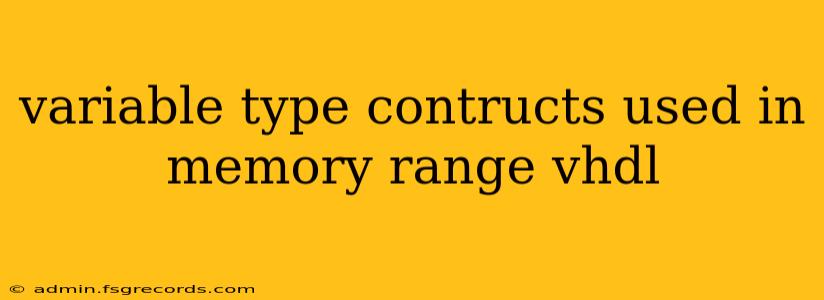VHDL (VHSIC Hardware Description Language) offers several ways to declare and use variables, especially when dealing with memory ranges. Understanding these constructs is crucial for efficient and accurate hardware description. This post delves into the different variable types and their applications within specified memory ranges in VHDL.
Understanding Memory Ranges in VHDL
Before exploring variable types, let's clarify memory ranges. In VHDL, memory is typically represented using arrays. These arrays can be one-dimensional (like a simple vector) or multi-dimensional (like a matrix). The range specifies the valid indices for accessing elements within the array. For example:
type mem_type is array (0 to 1023) of std_logic_vector(7 downto 0); -- 1KB memory
signal my_memory : mem_type;
This declares my_memory as a signal representing a 1KB memory block, where each element is an 8-bit vector. The range 0 to 1023 defines the addressable locations.
Key Variable Type Constructs for Memory Access
Several VHDL constructs are instrumental in manipulating data within memory ranges:
1. std_logic_vector
This is a fundamental type for representing bit vectors. It's frequently used as the base type for elements within memory arrays. It's ideal for representing data at the bit level.
signal data_byte : std_logic_vector(7 downto 0); -- Single byte
signal mem_location : std_logic_vector(9 downto 0); -- 10-bit address
2. integer
The integer type is suitable for representing addresses or index values within the memory range. It's crucial for iterating through memory or accessing specific locations.
variable address : integer range 0 to 1023;
3. unsigned and signed
These types extend std_logic_vector by adding arithmetic capabilities. They are beneficial when performing calculations on data stored in memory.
type word_type is array (0 to 15) of unsigned(15 downto 0); -- 16-word memory
signal word_memory : word_type;
4. Arrays and Records
As shown earlier, arrays are the primary way to represent memory itself. Records, on the other hand, can be used to structure data within memory.
type data_record is record
address : integer range 0 to 1023;
value : std_logic_vector(31 downto 0);
end record;
type mem_record_type is array (0 to 63) of data_record; -- array of records
signal record_memory : mem_record_type;
Best Practices and Considerations
-
Range Constraints: Always define clear ranges for your arrays and variables to prevent out-of-bounds errors. VHDL simulators and synthesis tools can help detect these errors, but explicit range specification improves code readability and maintainability.
-
Type Safety: VHDL's strong typing system helps avoid accidental mismatches between data types and memory elements. Carefully choose the appropriate types based on the expected data representation and operations.
-
Optimization: Synthesis tools can optimize code based on variable type declarations. Choosing appropriate data types contributes to efficient hardware implementation. For example, using
unsignedorsignedinstead of astd_logic_vectorcan enable optimized arithmetic operations. -
Clarity and Comments: Well-commented code is vital for understanding the purpose and usage of different variable types and memory ranges, particularly when working with complex designs.
This comprehensive overview provides a strong foundation for effectively employing variable types and memory ranges in your VHDL projects. Remember that selecting the right data types significantly impacts code clarity, efficiency, and the overall success of your hardware designs.

